The NCERT solutions for Class 8 maths enhance topics with frequent, focused, engaging math challenges and activities that strengthen math concepts. Each question of the exercise has been carefully solved for the students to understand, keeping the examination point of view in mind.
Class 8 Maths Chapter 4-Practical Geometry Exercise 4.1 questions and answers helps the students to understand the construction of a quadrilateral with lengths of four sides and a diagonal given.
Download PDF of NCERT Solutions for class 8 Maths Chapter 4- Practical Geometry Exercise 4.1
Access Answers of Maths NCERT Class 8 Chapter 4- Practical Geometry Exercise 4.1 Page Number 60
1. Construct the following quadrilaterals.
(i) Quadrilateral ABCD AB = 4.5 cm
BC = 5.5 cm
CD = 4 cm AD = 6 cm AC = 7 cm
Solution:
 The rough sketch of the quadrilateral ABCD can be drawn as follows.
The rough sketch of the quadrilateral ABCD can be drawn as follows.
(1) ∆ABC can be constructed by using the given measurements as follows.

(2) Vertex D is 6 cm away from vertex A. Therefore, while taking A as centre, draw an arc of radius 6 cm.

(3) Taking C as centre, draw an arc of radius 4 cm, cutting the previous arc at point D. Join D to A and C.

ABCD is the required quadrilateral.
(ii) Quadrilateral JUMP JU = 3.5 cm
UM = 4 cm MP = 5 cm PJ = 4.5 cm PU = 6.5 cm
Solution:
The rough sketch of the quadrilateral JUMP can be drawn as follows.
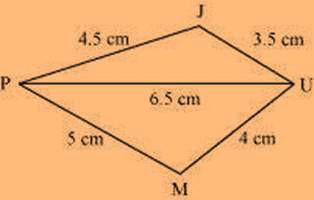
(1) ∆ JUP can be constructed by using the given measurements as follows.

(2) Vertex M is 5 cm away from vertex P and 4 cm away from vertex U. Taking P and U as centres, draw arcs of radii 5 cm and 4 cm respectively. Let the point of intersection be M.
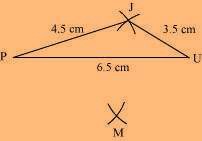
(3) Join M to P and U.

JUMP is the required quadrilateral.
(iii) Parallelogram MORE
OR = 6 cm
Solution:
RE = 4.5 cm
EO = 7.5
We know that opposite sides of a parallelogram are equal in length and also these are parallel to each other.
i.e., ME = OR, MO = ER
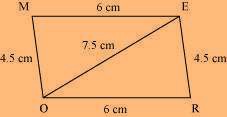 The rough sketch of the parallelogram MORE can be drawn as follows.
The rough sketch of the parallelogram MORE can be drawn as follows.
(1) ∆ EOR can be constructed by using the given measurements as follows.
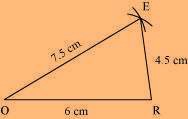
(2) Vertex M is 4.5 cm away from vertex O and 6 cm away from vertex E. Therefore, while taking O and E as centres, draw arcs of 4.5 cm radius and 6 cm radius respectively. These will intersect each other at point M.
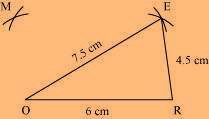
(3) Join M to O and E.
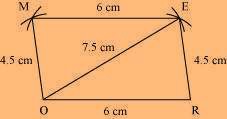
MORE is the required parallelogram.
(iv) Rhombus BEST
BE = 4.5 cm
ET = 6 cm
Solution:
We know that all sides of a rhombus are of the same measure. Hence, BE = ES = ST = TB The rough sketch of the rhombus BEST can be drawn as follows.
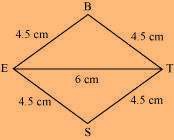
 (1) ∆ BET can be constructed by using the given measurements as follows.
(1) ∆ BET can be constructed by using the given measurements as follows.
(2) Vertex S is 4.5 cm away from vertex E and also from vertex T. Therefore, while taking E and T as centres, draw arcs of 4.5 cm radius, which will be intersecting each other at point S.
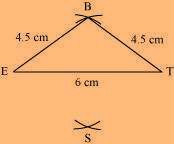
(3) Join S to E and T.
NCERT Solution For Class 8 Maths Chapter 4 Image
BEST is the required rhombus.